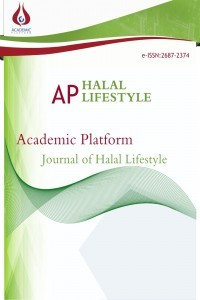Islamic Banks' Halal Profitability Analysis: Evidence from Oman
Islamic Banks' Halal Profitability Analysis: Evidence from Oman
Modern living gives us the chance to commemorate the many beautiful and unique religious traditions and to highlight the many benefits that society gains from their preservation. Commercial banks were founded in a framework distinct from the Islamic context, with distinct foundational ideals and paradigms. As a result, most Muslims have not largely accepted those banks. In Oman, where the banking system transformed from regular public banking services to Islamic banking services to meet the demands and requirements of the Sharia Complaint system where interest is not utilized as guided by Islamic economics. Hence, the focus of this research is on the halal earnings of Islamic banks. This study's major objectives are to empirically investigate and evaluate the halal profits of Islamic banks in Oman while highlighting crucial information about banking performance that can help decision and policymakers in the banking industry. An analysis of the financial statements for the two Islamic Banks for the five years covering 2017 to 2021 allowed for the determination of the halal earnings from a financial perspective. This research topic was covered using secondary sources. In addition to using quantitative research to determine the relationships, this study was undertaken to investigate the halal profit of Islamic banks. Halal profit guarantees that the bank's earnings are obtained ethically and legally, in accordance with the standards and principles held by its society. Discussion in this paper is expected to serve as a road map for a future initiative to elevate Islamic banking by maintaining an unwavering focus on innovation and the desire to provide excellence in everything banks do, including the development and provision of a wide range of integrated products and services that are completely compliant with Sharia principles.
Keywords:
Halal Profit, Omani Banks, Financial Analysis, Islamic Banks, Sharia-compliant financial solutions Halal Life,
___
- Adelopo, I., Lloydking, R., and Taurigana, V. (2017). Determinants of bank profitability before, during, and after financial crisis. Int. J. Manag. Finan. 14, 378–398. Doi: 10.1108/IJMF-07-2017-0148
- Ahamed, F. (2023). Evolution of Oman’s Islamic Banks. Ind. J. Sci.& Tech, 16(17), 1302–1308. https://doi.org/10.17485/ijst/v16i17.600
- Ahamed, F., & Shahul Hameed, D. G. (2010). Development of Islamic Banking with Reference to UAE. SSRN. https://ssrn.com/abstract=1621442
- Ahamed, F., & Shukla, V. K. (2023). The Rise of the Omani Digital Payment Sector: Trends, Adoption, and Future. 2023 ICCIKE. https://doi.org/10.1109/iccike58312.2023.10131889
- Alharbi, A. T. (2017). Determinants of Islamic banks’ profitability: international evidence. Int. J. Is. And ME Finan. Manag. 10(3), 331–350. https://doi.org/10.1108/imefm-12-2015-0161
- Aliyu, S., & Yusof, R. M. (2016). Profitability and Cost Efficiency of Islamic Banks: A Panel Analysis of Some Selected Countries. Int. J. Eco. Finan. Issues. 6(4), 1736–1743. Retrieved from https://www.econjournals.com/index.php/ijefi/article/view/2799
- Alzadjal, M. A. J., Abu-Hussin, M. F., Md Husin, M., & Mohd Hussin, M. Y. (2021). Moderating the role of religiosity on potential customer intention to deal with Islamic banks in Oman. J. of Isl. Mkt. 13(11), 2378–2402. https://doi.org/10.1108/jima-05-2020-0150
- Annual Reports (2014). Bank Nizwa (n.d.). Retrieved from https://www.banknizwa.om/market-disclosures/annual-reports/
- Aslam, M., Inamullah, I., & Ismail, M. (2016). Determinants Affecting the Profitability of Islamic Banks: Evidence from Pakistan. Int. J. of Ope. And Log. Volume 5, Issue 2, Pages: 115-127
- Basu, R., Prasad, A., & Rodriguez, S. (2015). Monetary Operations and Islamic Banking in the GCC: Challenges and Options. IMF Working Papers, 15(234), 1. https://doi.org/10.5089/9781513588513.001
- Buchory, H. A. (2015). Banking profitability: How does the credit risk and operational efficiency effect? J. of Bus. And Mgt. Sci. 3(4), 118-123. http://doi:10.12691/jbms-3-4-3
- Central Bank Of Oman - Quarterly Statistical Bulletins. (n.d.). 2023. https://cbo.gov.om/Pages/QuarterlyBulletins.aspx
- Elsiefy, E. (2013).Determinants of profitability of commercial banks in Qatar: Comparative overview between domestic conventional and Islamic banks during The period 2006-2011. Int. J. of Eco. And Mgt. Sci. 2(11), 108-142.
- Field, A. (2009). Discovering Statistics Using SPSS. 3rd eds. London: Sage Publications.
- Hassan, S., & Ahmed, R. (2019). Internal determinants of Islamic bank profitability: Evidence from Bangladesh. Int. J. Eco and Finan. Res. 5(7), 171-176. https://doi.org/10.32861/ijefr.57.171.176 Islamic Banking Services. (n.d.). Islamic Banking Services. https://www.kfh.bh:443/bahrain/en/personal/about-us/islamic-banking-services.html
- Islamic Financial Services Board (IFSB). (n.d.). Islamic Financial Services Board (IFSB). Retrieved from https://www.ifsb.org/sec03.php
- Islamic Financial Services Board. 2022. Islamic Financial Services Industry Stability Report. Kuala Lumpur, Malaysia, June
- Jallow, C. (2022). Banking Performance in OIC Member Countries: A Panel Study of Selected Islamic Banks. Asi. J. of Eco. Busi. and Acco. 131–139. https://doi.org/10.9734/ajeba/2022/v22i1930664
- Loghod, H.A. (2011), Do Islamic Banks Perform Better than Conventional Banks? Evidence from Gulf Cooperation Council Countries, Working Paper, Arab Planning Institute, pp. 1-28
- Magd, H. A., & McCoy, M. P. (2014). Islamic Finance Development in the Sultanate of Oman: Barriers and Recommendations. Proc. Econ. and Finance, 15, 1619–1631. https://doi.org/10.1016/s2212-5671(14)00633-9
- Malti, F. (2022). A Brief History to Modern Islamic Finance (PART 1). Retrieved from https://mcca.com.au/a-brief-history-to-modern-islamic-finance-part-1/
- Muda, M., Shaharuddin, A., & Embaya, A. (2013). Comparative analysis of profitability determinants of domestic and foreign Islamic banks in Malaysia. Inter. J. of Eco. and Finan. Issues. 3(3), 559-569.
- Mendoza, J. (2023). Oman’s Islamic banking share to rise steadily this year: Fitch. Oman Observer. https://www.omanobserver.om/article/1133703/business/omans-islamic-banking-share-to-rise-steadily-this-year-fitch
- Oino. I. (2015). Competitiveness and determinants of bank profitability in Sub-Saharan Africa. Inter. J. of Eco. and Finan. 7(10), 151-162. https://doi.org/10.5539/ijef.v7n10p151
- Oman's Islamic banking assets jump 9.6% to ro6.2bn (2022) Muscat Daily. Retrieved from: https://www.muscatdaily.com/2022/08/28/omans-islamic-banking-assets-jump-9-6-to-ro6-2bn/
- Smaoui, H., & Salah, I. B. (2011). Profitability of Islamic banks in the GCC region. In Annual Paris Conference on Money, Economy, and Management. 1-26.
- Tharu, N. K., & Shrestha, Y. M. (2019). The influence of bank size on profitability: An application of statistics. Inter. J. of Finan, Acco, and Manag. 1(2), 81–89. https://doi.org/10.35912/ijfam.v1i2.82
- Yüksel, S. (2022). Gen Z as Halal Consumers: Omani Scope. Academic Platform Journal of Halal Lifestyle, 4 (2), 38-49. DOI: 10.53569/apjhls.1038904
- World Bank Open Data. (n.d.). World Bank Open Data. https://data.worldbank.org
- Yayın Aralığı: Yılda 2 Sayı
- Başlangıç: 2019
- Yayıncı: Akademik Perspektif Derneği
